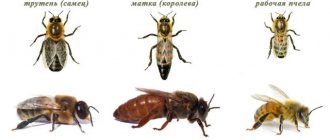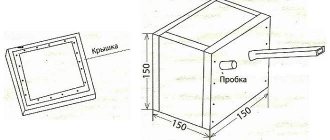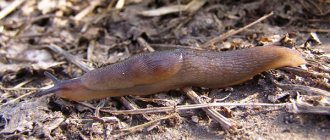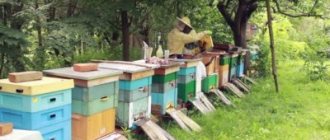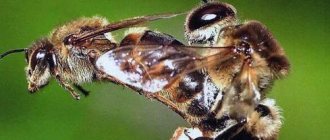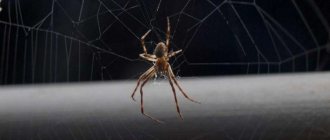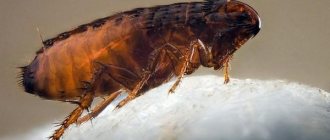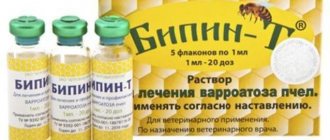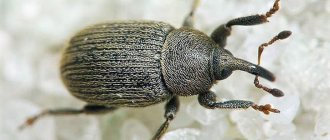Autumn care for bees consists of a rather large list of activities that should complete the period of the main honey collection and prepare the insects for a prosperous, safe winter. Competent beekeepers are sure: the more correctly and well you do your autumn work, the better products you will get next season.
Terms and Conditions
Bees, like people, need to get used to a group, so the end of August-beginning of September and until the beginning of October is considered a good time to unite. This will have a positive effect on the future wintering of the joint family.
The beekeeper must initially examine both colonies and independently decide on combining 2 unrelated offspring. Even with an urgent need to breed a healthy brood and honey cakes, a medical examination must be carried out. Conditions under which a strong family is determined:
- Each brood contains at least 3 individuals;
- 2 future joint houses in one common hive will be healthy;
- Each relative will have food;
- There is a healthy and productive uterus.
This brood is capable of producing strong offspring, can go into a swarm state and survive the winter. In all other cases, when at least one point is violated, it is necessary to unite weak representatives.
The purpose of uniting families
The union of two different families into one is considered a responsible, important process, which implies the formation of a new healthy family. In this way, you can create a strong, stable, powerful and productive family in the fall.
When a beekeeper wants to combine several bee swarms or families into a single whole, he may have different goals. The most optimal and main task is to create a strong and healthy colony by adding strong bee individuals to the weak ones. However, everything must be done correctly and with extreme caution.
In those families in which there is a queen, you can safely add pre-formed layering. Connecting several families in the fall is a difficult process, since a mutual attack of insects can break out at any moment. Families of such insects are equipped with a special instinct - protective. That is why, in the event of the formation of a foreign and foreign smell, a brutal attack on the “enemies” may begin.
Methods
There are many ways to combine two houses, so each beekeeper selects the conditions for himself. The main thing in autumn is to choose good weather, when the drones have flown away for nectar.
With feeding
There is no need to move the houses, but step-by-step preparation is necessary. On the weakest club you need to put honeycombs with honey, which are 1/3 or half filled. After two weeks, feeding should be repeated to appease and weaken the aggression of insects. Usually they feed 2-3 times, then the insects begin to get used to it, which will affect their productivity.
Now you need to deal with a strong family and check for the presence of a uterus (the examination is carried out in a warm place). After this, the “strong” comb is sent to the fed house. The unification of weak bee colonies on their own is successful if several frames of the strongest of the weak ones are transferred to the weak one. Insects get used to the smell.
Through the partition
The technique will be similar to relocation using newspaper, but it will require the dexterity of a beekeeper. The hive with a weak family is gradually moved closer to the strong one (1-2 meters in 3 days), after which it is placed on the open house of a strong family.
First, a partition made of any wood must be placed between the dwellings. After three days, the insects will get used to the neighbor’s smell, and the partition can be removed. The time for removing the obstacle should be in the evening.
Through the newspaper
The method is widespread in Siberia, where many honey plants bloom early. The method is best used in mid-September:
- One of the hives needs to be moved 1 meter towards the future common house every 2-3 days, turning it 30 degrees;
- Remove the queen a few hours before complete union;
- Both cabins are disinfected to prevent illness;
- Place a regular newspaper on the house of individuals that are considered stronger;
- Place the house of weak offspring on top.
The effectiveness of this method has been noticed more than once, since there is always the strongest of the weak families, which gnaws through the newspaper and takes out the remains from the neighboring hive. Mutual improvement of the new home brings the insects together, so no problems arise.
Through the gangway
In this method, you will need to move both houses towards each other, gradually turning them over. To the house where strong offspring live, you need to place a small sheet of plywood at an angle so that it reaches the last honeycomb. Before relocation, it is important to remove the womb from the weakest, but preserve it.
Now you can begin resettlement. To do this you will need a smoker and a little patience. After the streets become filled with smoke, the hive closes and you need to knock on the walls of the house. After a couple of minutes, the stream of bees, sensing danger, will leave their previous habitat.
During the flight, you need to have time to spray the individuals on the gangplank with a sweet solution of sugar and aromatic herbs so that both houses have the same smell. If there are insects left in the hive, they must be shaken off onto a plywood gangway; they will crawl to their new place of residence. Now you need to wait until each smoked resident has moved along the gangplank to the strongest family, but in no case should you rush them (and do not fumigate them!), as they may leave the apiary.
Spraying
An elementary method that does not require reading thick books on beekeeping. To implement it, it is enough to dissolve sugar in water (1:2) and mix it with a fragrant decoction of honey-bearing herbs. The result should be a sweet and cloying aroma that will help connect the two houses. The main thing you need to remember is the time of its application: the bulk of honey plants should bloom (late August-early September).
Gradually bringing the houses closer by a meter or two over three days helps the bees get used to the landscape. After the hives have converged at one point, you can spray the bees and the hive. This should be the evening when the bees will no longer go to honey collection.
Both families will begin to lick sweet “nectar” from each other and will gradually get used to the common smell.
Methods for connecting bee colonies
Each bee colony has a certain smell, which collectors and receivers can easily identify. The introduction of strangers with an unfamiliar smell is perceived with aggression, especially if the bee colony is with its reproductive queen. There are several methods for uniting bee families:
- uniting a weak bee colony with a strong one;
- strengthening an average bee colony with a colony left without a queen;
- creating a honey honey colony based on spring layering;
- connection of a captured swarm and an old family of bees;
- moving two clearly defective nests into a new hive;
- union of swarms.
Important!
Before bee colonies from different hives are united, they are treated with a scented substance. The treatment disorients the individuals responsible for guarding the hive. Before bee colonies are united in the fall before wintering, the insects are fed the same syrup with the addition of strong-smelling herbs or substances. Capped honey in combs from different hives will have the same smell.
Precautionary measures
Expanding housing conditions for joint families usually does not cause difficulties, but beekeepers should adhere to several conditions:
- Bees should not be stressed or brought together in bad weather (cold, damp...);
- Transplantation should be carried out among insects of the same breed, in order to avoid bullying and a healthy gene pool;
- You always need to monitor the queen and even during nesting she needs to be looked after and fed, otherwise she will die.
These are the main mistakes that can be made during the initial transplant of 2 families. Also, do not forget about possible “quarrels” within the new family, so you need to monitor the house every day so that there is no rebellion.
Preliminary procedures
Insects can be combined with or without queens. Only the tinder fungus needs to be corrected first. This can be done practically at any time of the season. Of course, you shouldn’t touch insects in winter.
This is interesting Treatment and prevention of bees from acarapidosis
The presence of the uterus in one of the connected nests or in both plays a positive role. To unite families without queens, you need to first calculate what would be better: breed a new queen for her or combine insects with someone else.
It is not recommended to breed queens in the spring, since at this time there are no necessary conditions for obtaining a high-quality individual.
Also, you should not do this in the fall. The mother must emerge from the queen cell no later than September 10, otherwise she will not cope with the difficulties.
In this regard, you should first think carefully about everything and calculate the date of hatching of the queens.
Tips and tricks
Practical advice from which more than one generation of beekeepers has learned will help insects survive relocation as painlessly as possible:
- Both houses can be smoked in advance with a smoker to facilitate the transfer;
- A little patience. Insects cannot be rushed, much less moved independently;
- Do not close your eyes. If there is no brood in the house, but you consider the family to be strong, it is better to unite it;
- Monitor the temperature. In October, you need to carefully monitor temperature changes; it is forbidden to combine in sub-zero weather.
The formation of a new “cell” of the bee society requires close attention, so you should not count on the independent formation of a nest of bees. Help the insects, but don't overdo it.
Basic Safety Precautions
Before summing up, it is important to consider all the principles related to the behavior of the beekeeper at the time of such an operation in the apiary:
- The work is carried out in the evening, when almost all insects are sitting in the hives, and their activity is at zero. According to professional beekeepers with many years of experience, such manipulations can begin no earlier than six o’clock in the evening, but no later than eight o’clock.
- Relocation should be carried out in calm, clear weather, so that there are no reasons for aggressive and attacking behavior among insects.
- Do not forget about good, mandatory and nutritious feeding, which is done before or after the procedure.
- Before you begin the manipulation, you need to work with the smoker, namely, blow on the bees. Thus, insects will be able to capture the largest amount of honey products in the proboscis. As a result, they will become calm and peaceful. Consider an equally important factor related to the fact that those individuals who have filled their crop well are perfectly accepted in another hive.
- For successful and fruitful development, it is necessary to transfer weak individuals to stronger ones.
- As for the mother, namely the owner of a particular home, she must first be kept in a cage in order to keep her alive.
- It is desirable that the bees have the same smell, so that the adaptation occurs much more efficiently and successfully. It is important to know that they are able to sense their honeycombs, so with them they will be calmer, more peaceful.
- In beekeeping, it is prohibited to combine infected insects with healthy bees to prevent infection.
If you follow the proposed recommendations and accurate advice, the beekeeper has the opportunity to carry out such work to the highest standard.
Uniting bee colonies in the fall is a familiar and inevitable procedure in every apiary. With any configuration, by the end of summer there will be one or several weak colonies that will not survive the winter. It is recommended to unite bee colonies for better productivity during honey collection.
When and in what cases is bee colonies united?
Only a strong and stable colony of insects can survive the winter and live for many years. After the end of the main honey collection, the beekeeper must check the insects and take measures for a successful wintering.
If during the season the bee colony has not managed to increase a sufficient number of individuals, then the method of unification is used to strengthen it. It involves uniting several weak bee colonies into a common one or joining a weak one to a stronger one.
How to unite bees in the fall
The process of uniting bee colonies is simple, and any beekeeper can cope with it. But before moving the swarms into one hive, it is necessary to prepare the insects and create a common smell. Bees recognize a family by its scent and will destroy insects with a different scent from theirs. If you do not take care of creating a common smell in advance, then two bee colonies will destroy each other.
There are several ways to combine flavor:
- Spray each cell of both hives with a weak sugar solution with the addition of aromatic oils of camphor, mint, lemon balm and other plants with a pungent odor.
- Unite two colonies in a common hive, but separate them using a mesh or plywood partition. Then, after some time, the scent of the bees will become uniform, and during the period of scent unification, the insects will not be able to harm each other. Their young brood will share a common scent. Newspaper or sheets of paper can also be used as a partition.
Before combining colonies, the beekeeper must select one queen and place it under a queen cap to prevent it from being damaged. You can leave all the queens in the hive, and then the bees themselves will choose the strongest one and destroy the rest.
Sugar syrup
Uniting bee colonies in the fall through a newspaper
This option involves gradual mixing of the smells of two families. It is smooth and calm for the bees, but more difficult for the beekeeper. It is necessary to constantly monitor the integrity of the partition between them.
A strong swarm is placed in the lower nest with the frames of a multi-body hive, and a newspaper or paper sheet is placed on it. 20 holes are made in the paper using a needle or taps to allow air with insect odors to pass through. The second family is placed in the upper housing.
Uniting bee families before honey harvest
Similarly, bee colonies are united before honey harvest and in the spring. In this case, it is better to combine both methods at once: first spray the honeycombs with a strong-smelling solution, and then transplant them into one hive, separated by a partition. This way you can unite two bee colonies with minimal losses.
